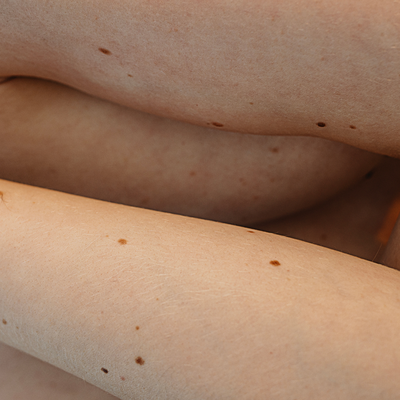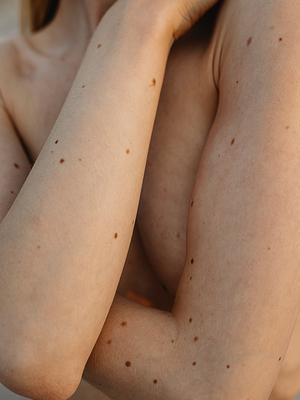

Everything You Need To Know About Mole Health
What are the main things to look for with moles?
Tracking changes in mole health can feel overwhelming and intimidating, but don’t let that stop you from doing your due diligence. “It's essential to observe changes in size, shape, colour and texture,” says aesthetic practitioner Dr Raquel Amado. “Asymmetry, irregular borders and evolving characteristics can indicate potential concerns. Additionally, any symptoms like itching, bleeding or tenderness should be noted.”
It’s also important to consider the big picture. “Family history of melanoma or excessive sun exposure should be taken into account,” says Dr Anjali Mahto, consultant dermatologist at Self London, who says it’s worth checking areas not typically exposed to the sun as well. Anjali also advises being aware of any atypical features across your body, as individuals with numerous atypical moles are at higher risk. “Regular self-examinations are crucial for early detection and management of suspicious moles. If you are concerned at all, speak with your GP.”
How often should you get them checked?
If you have a personal or family history of skin cancer, it’s sensible to stay on top of professional monitoring and get them seen to every 3-6 months. If you’re relatively low risk, an annual check-up is probably adequate.
How can you keep on top of multiple moles?
If you have lots of moles, it’s important to stay organised. “Establish a routine of regular self-examinations as well as booking in for a frequent mole check with a consultant dermatologist,” says Anjali. “As long as you’re vigilant, you should be fine.”
Where can you get moles checked?
Your GP or dermatologist is always a sensible first port of call if you notice changes or are worried about the size, shape or feel of any of your moles. If you do have a lot, you may want to take a pre-emptive approach and get your moles mapped so that any changes can be easily and accurately tracked. OneWelbeck’s mole mapping technology uses a whole-body 3D imaging system to capture the entire skin surface in macro-quality resolution in under ten seconds. It’s the most advanced form of mole mapping available in the UK, and helps maximise early detection of any problems, which can in turn lead to improved survival rates for skin cancer.
Do irregular moles always mean cancer?
“Irregular moles don’t always indicate cancer, but they can be a cause for concern and should be evaluated by a dermatologist,” says Anjali. If you do notice changes, it still doesn’t necessarily equal bad news. According to Anjali, only a small percentage of irregular moles turn out to be cancerous. “While irregularity increases the likelihood of malignancy, it's not definitive,” agrees Raquel.
How easy is it to get moles removed?
Although a lot will depend on the size, location and type of mole, getting them removed is a fairly straightforward process. Usually performed as an outpatient procedure by a dermatologist or medical professional, the vast majority are dealt with under local anaesthetic, although there are several different methods that may be used.
“Common techniques include surgical excision, where the mole is cut out and the skin stitched closed, or shaving, where the mole is shaved off at skin level,” says Anjali. “In some cases, laser therapy or cryotherapy may be used.” However your mole is removed, and whether or not cancer is suspected, it is important to ensure you have it done by someone who will follow the appropriate course of action post-procedure. “It’s paramount that anything removed is sent off to histology to check for any cancers,” says Anjali. “This is why having moles taken off at a high-street beauty clinic isn’t recommended.”
Any lifestyle tips on how to look after existing moles?
Anything you can do to keep your skin safe in the sun, especially if your skin cancer risk is elevated, is essential. “Prioritise sun protection by wearing protective clothing, seeking shade and using broad-spectrum sunscreen regularly,” says Anjali. Raquel advises avoiding tanning beds, and advocates regularly moisturising the skin and staying hydrated to improve overall skin health. Staying informed about skin cancer risks and any warning signs to look out for is also key.
The ABCDE acronym is a helpful tool for assessing moles:
Asymmetry:
Check if one half of the mole looks different from the other half.
Border Irregularity:
Normal moles typically have smooth, even borders, whereas irregular, notched, or blurred edges may indicate a problem.
Colour Variation:
Look for changes in colour within the mole or the presence of multiple colours, including shades of brown, black, red, white or blue.
Diameter:
While melanomas are often larger than 6mm in diameter, any mole that is growing should be monitored.
Evolution:
Keep an eye on any changes in the mole over time, such as changes in size, shape, colour or symptoms like itching or bleeding.
DISCLAIMER: Features published by SheerLuxe are not intended to treat, diagnose, cure or prevent any disease. Always seek the advice of your GP or another qualified healthcare provider for any questions you have regarding a medical condition, and before undertaking any diet, exercise or other health-related programme.
DISCLAIMER: We endeavour to always credit the correct original source of every image we use. If you think a credit may be incorrect, please contact us at info@sheerluxe.com.